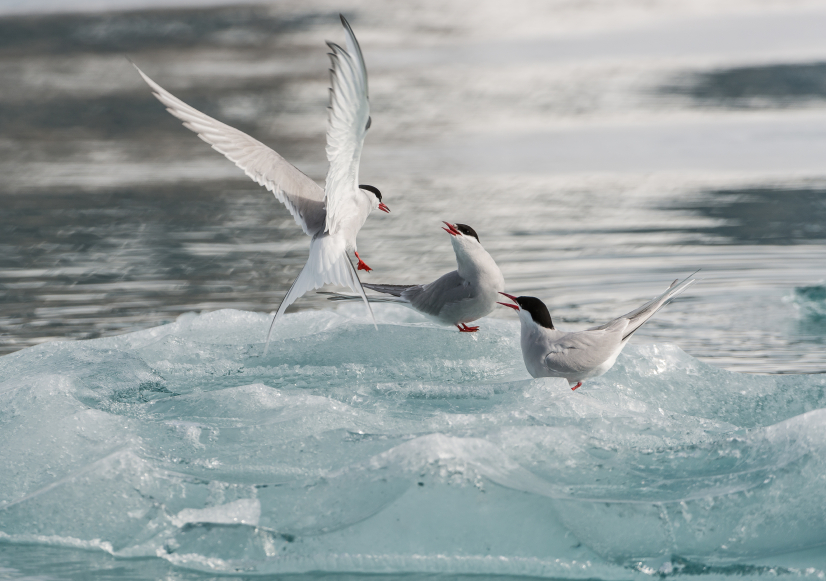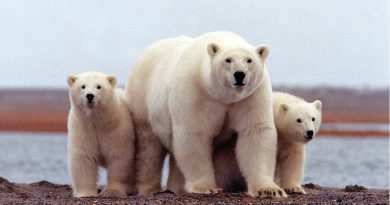Shippers and seabirds clash over Arctic territory says study

The areas coveted as sea routes for commercial shippers seeking to exploit newly ice-free Arctic waters are the same areas that are vital to millions of seabirds that flock north each summer to feast under the midnight sun, says a newly published study.
The Arctic is not big enough for both birds and shippers, suggests the study, published in the April issue of the journal Diversity and Distributions.
“There is a competition for space, and the space has already been occupied by seabirds,” said co-author Falk Huettmann of the University of Alaska Fairbanks’ Institute of Arctic Biology, co-author of the study published in the journal Diversity and Distributions.
Huettmann and co-author Grant Humphries, of the University of Otago’s Zoology Department, mapped out marine habitat used by 27 species of Arctic seabirds and compared those areas to routes already being used by Arctic shippers or contemplated for shippers’ future use. They found that shallow continental shelf areas, where marine life is richest and ice is thinnest, is vital territory for migrating bird populations. But it is also key territory for commercial operators seeking to boost shipments to and from the Arctic.
The hotspots
A key hotspot is the Bering Strait between Alaska and Russia, famous for its abundant seabird and wildlife populations but also a crucial — and narrow — passage for commercial operators heading in and out of the Arctic. The area has the greatest overlap of seabird diversity and ship activity and the highest potential for conflict, the study says. Another area of “high impact” is likely to be the Davis Strait and Baffin Bay region, entry into the Northwest Passage, the study says.
“To enter the Arctic basin, you have to go through these bottlenecks,” Huettmann said.
Additional trouble spots include the Greenland Sea and Norwegian Sea, the study said. Areas of thick multiyear ice, in contrast, are not of much interest to either birds or shippers.
Where there is competition for space, shipping poses significant risks to Arctic seabirds, from oil spills created by marine wrecks, obviously, but also from routine operations, Huettmann said.
Ship traffic creates chronic water pollution from small oil and grease leaks, he said. Ship noise is known to disturb marine life. Invasive species are already being carried by ships to the far north, and air pollution produced by marine fuels is “dramatic.”
“You can actually track from space where these vessels go because of the bunker fuel,” he said.
Disruptions to flight patterns
The very presence of large ships creates a visual change that threatens to disrupt flight patterns and create new stresses in seabird populations, according to Huettmann. Birds like gulls are known to be attracted to ships, meaning flight patterns are likely to be disrupted as the birds follow the vessels and their bright lights. Such disruptions will mean ripple effects for other bird populations, like greater predation, he said.
Any shipping-related disruptions are on top of the myriad climate-change impacts already underway on Arctic lands and in freshwater systems feeding into the Arctic Ocean, Huettmann said.
He fears that seabirds, unlike charismatic animals like polar bears, have already been neglected and “marginalized” in the commercial rush to the Arctic — even by government environmental agencies and nongovernmental environmental organizations. He said he hopes that seabirds’ territory will be respected before Arctic shipping is expanded but is pessimistic about the chances for that. There should be a cost-benefit analysis that considers full impacts, including those to seabirds, he said. “Perhaps there’s some benefit to shipping, but I’d like to see what it is,” he said.
A similar mapping project was recently completed for three types of whales found in Arctic regions where new oil and gas development and new shipping has started or is anticipated.
That project, with results published in the February issue of the journal Marine Policy, considers bowhead whales, belugas and narwhals and the overlap of their habitat with sites around the Arctic that are being used or eyed for petroleum development and shipping.
Offshore oil and gas development and ship activity present major risks to those whales, said the study, authored by scientists from Alaska, Canada, Greenland, Norway, Switzerland and the Netherlands. The mapping project was launched by the World Wildlife Fund and its species-conservation programs.
Shipping conflicts
The Bering Strait is identified in that study, too, as a hotspot for potential conflicts with shipping.
“I call it ‘The Manhattan of the Arctic,’ because every year, 12 million seabirds go there to forage for food,” said Margaret Williams, managing director of the World Wildlife Fund’s U.S. Arctic program. She has a second nickname for the Bering Strait, used by 10,000 bowhead whales each year, plus other migrating animals: “The Marine Mammal Superhighway.”
Williams seems more optimistic than Huettmann about future controls on Arctic shippers. “This is something where good planning can make a big difference,” she said.
Some organizations have concluded that increased Arctic shipping is inevitable.
By 2022, the number of vessels operating in the Arctic will increase by 34 percent over 2012 numbers, and total activity, measured in days of ship operation, will be doubled, a recent U.S. Navy report predicted.
The Navy’s 2014-2030 Arctic Roadmap released on Feb. 24 said most Arctic shipping activity in the near future will continue to take place in the Barents and Norwegian Seas, areas that are already ice-free, but that shipping will increase in the Bering Strait and Northern Sea Route as annual ice-free periods expand.
Still, the Arctic will account for only a small portion of worldwide vessel traffic in the near future, the Navy said. The Arctic’s share of global commercial maritime activity is likely to be 2 percent to 4 percent in 2022, compared to 1 percent to 2 percent in 2011, the Navy said.
Contact Yereth Rosen at yereth@alaskadispatch.com
Related Links:
Canada: Scientists plan to monitor underwater noise in the Northwest Passage, Alaska Dispatch
United States: Feature Interview – What acoustics can tell us about whales in the Arctic, Eye on the Arctic



